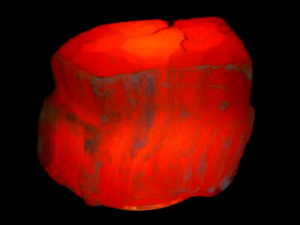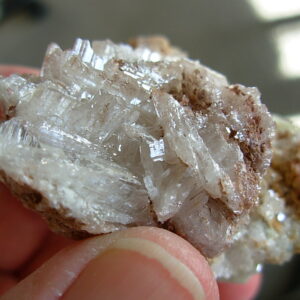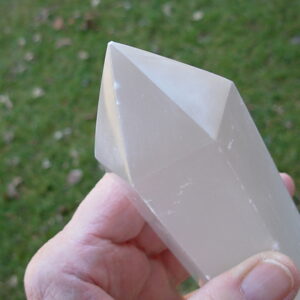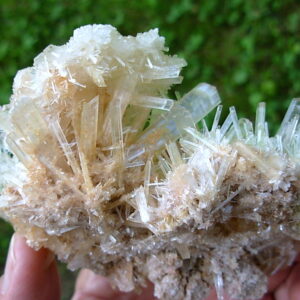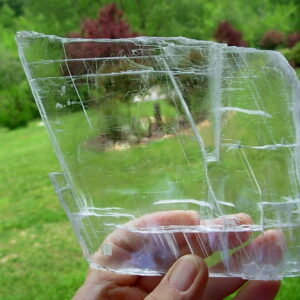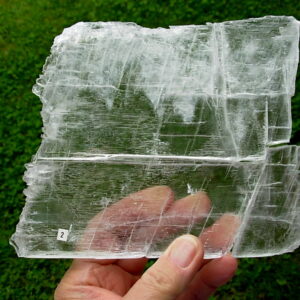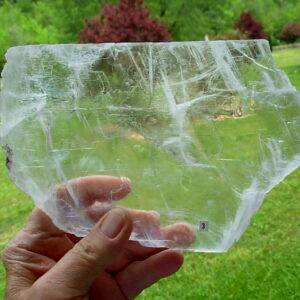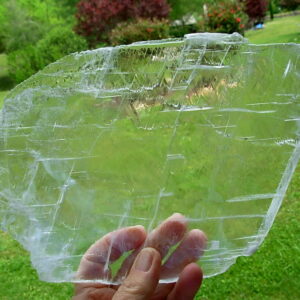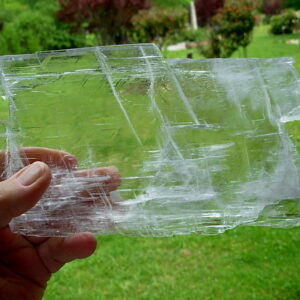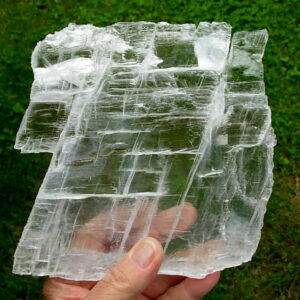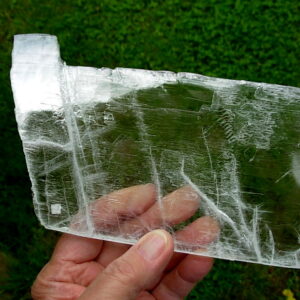Selenite variety of Gypsum
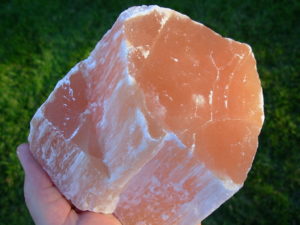 Selenite...is a variety of Gypsum... and is one of the most common, rock-forming minerals, developing thick beds formed by the evaporation of extremely salt laden waters. Gypsum is associated with halite and sulfur. It is deposited from lakes, seawater, hot springs, volcanic moisture, and sulfate solutions in underground veins. Anhydrite in underground veins can be converted into gypsum by hydration from groundwater close to surface areas. Gypsum dissolves over time in water, and is rarely found in the form of sand.
Selenite...is a variety of Gypsum... and is one of the most common, rock-forming minerals, developing thick beds formed by the evaporation of extremely salt laden waters. Gypsum is associated with halite and sulfur. It is deposited from lakes, seawater, hot springs, volcanic moisture, and sulfate solutions in underground veins. Anhydrite in underground veins can be converted into gypsum by hydration from groundwater close to surface areas. Gypsum dissolves over time in water, and is rarely found in the form of sand.
A well known oddity is the White Sands National Monument in the state of New Mexico. The unique conditions there have produced a 275 square mile area of white gypsum sand. In 1933 President Herbert Hoover declared the gypsum dunes a protected national monument to prevent commercialization of the area.
When heated under appropriate conditions, gypsum forms plaster of Paris. Gypsum is extremely useful for many practical applications and for works of art. In particular, it is used for wallboard for buildings, as a component of concrete for the construction of highways and bridges, and as a soil conditioner for agriculture. The Clear variety is called selenite. The translucent variety, called alabaster, is a valuable ornamental stone. When converted to plaster of Paris, it is used in sculpture, architecture, fire protection, and theatrical sets. There are many formations of Gypsum that make outstanding collection specimens, and it is a favorite of rockhounds!
For a description from Wikipedia, the free encyclopedia http://en.wikipedia.org/wiki/Gypsum
Orange Selenite Information
Orange Selenite is a very impressive stone. It has a peachy orange color and has white fibrous strands as you can see from the rough sides. It carves and polishes easily and displays a brilliant orange (see picture on right side) when backlit or placed on a lighted display. Most of this is found in Pakistan or Morocco and is rather difficult to find quality specimens for carving as other minerals form in the selenite. Most of the less pure specimens are made into candle holders for Tea Light or Votive styles of Candles.
Selenite Specimens for Sale
Selenite Ice from Utah
The Gypsum Selenite Ice listed below is from Hanksville in Wayne County, Utah. Gypsum Selenite has many interesting properties, and has very unique crystal habits. Many Gypsum crystals are found perfectly intact without distortions or parts broken off. Such crystals are found in a clay beds as floater crystals, where they fully form without being attached to a matrix. Most Gypsum has some matrix attached. Clear or colorless Gypsum is often referred to as selenite Ice due to its high sheen. Fibrous compact white Gypsum is referred to as White Gypsum Satin Spar due to its satin sheen.
Gypsum has the same composition as the mineral Anhydrite, except it has water in its structure. Many Anhydrite specimens absorb water, transforming into Gypsum. Gypsum specimens show evidence of the transformation by developing disintegrating layers that appear to spread due to the expansion from the added water. Gypsum specimens should only be cleaned with water. Soaps and detergents should never be used because they can infiltrate the crevices of a crystal and ruin its beautiful luster.
-
Utah Colorless Gypsum Selenite Ice
$42.40 Read more -
Utah Colorless Gypsum Selenite Ice
$38.40 Add to cart -
Utah Colorless Gypsum Selenite Ice
$39.40 Add to cart -
Utah Colorless Gypsum Selenite Ice
$56.40 Add to cart -
Utah Colorless Gypsum Selenite Ice
$46.40 Read more -
Utah Colorless Gypsum Selenite Ice
$48.40 Add to cart -
Utah Colorless Gypsum Selenite Ice
$41.40 Add to cart -
Utah Colorless Gypsum Selenite Ice
$33.90 Add to cart


